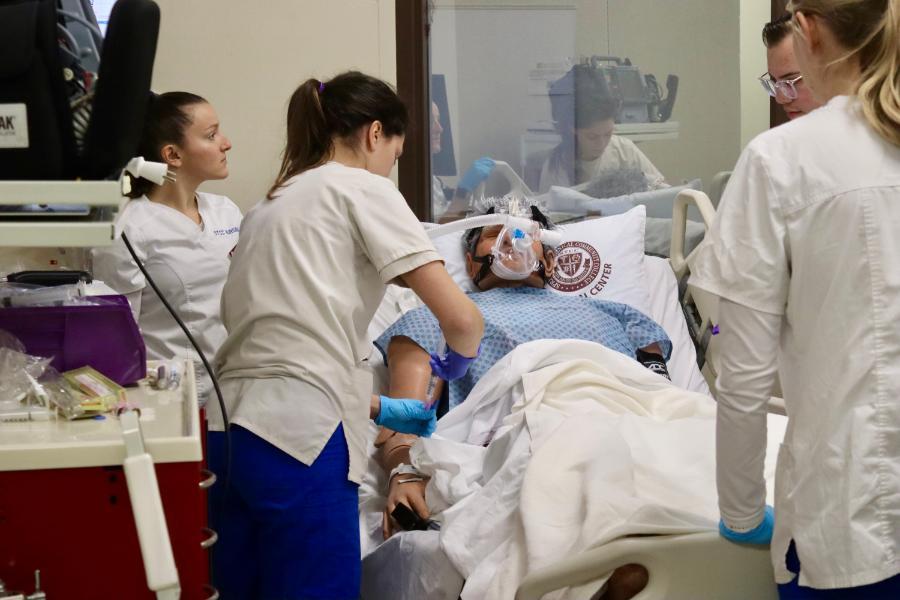STCC senior nursing students spend day following patient in variety of scenarios
SPRINGFIELD, Mass. – For a few tense moments, the patient’s heart stopped beating. Second-year nursing students at Springfield Technical Community College were performing CPR in an attempt to save his life.
The patient, Peter Stevyanovich, was actually a high-fidelity simulator at the SIMS Medical Center on the STCC campus. The “code scenario,” which means the patient went into cardiac arrest, took place at a “long-term care facility” in the Progressive Care Unit of the SIMS Medical Center. It was the first scenario for the students who embarked on an immersive day-long learning experience.
Throughout the year, senior students dedicate their time facing health scenarios with a patient to understand multiple transitions of care, said Deborah Jacques, a nursing professor at STCC. Voiced by a staff member in a control room, the patient simulators talk to the students. As in real life, patients can be hard to understand and can get agitated because they are in pain. The simulators also emit real life odors and feature wounds and conditions that look real. STCC staffer Michael Baran, a technical specialist II, puts his talent to work not only voicing the simulator, but he creates some of the Hollywood-like effects to make the simulators look real.
“They start in a rehab setting where the patient requires CPR, and they communicate extensively with outside personnel (such as EMTs),” Jacques explained. “The goal is to help them master effective communication and prevent any loss of critical patient information.”
The experience allowed them to work through a code scenario in a safe environment where mistakes could be made and learned from without real-world consequences.
“If they freak out or do something wrong, it’s OK,” Jacques said. “This practice helps alleviate their anxiety by building muscle memory through repeated exposure to simulated emergencies.”
STCC staff played the role of emergency medical technicians, further enhancing the realism of the exercise. Students were trained to execute a “warm handover,” a face-to-face patient report exchange that ensures seamless communication between nurses and EMTs.
“It’s about giving a complete report on the patient and preparing EMTs for what to expect during transport to the hospital,” Jacques said.
On Feb. 4, all students worked with the same patient simulator, Peter Stevyanovich, tracking his medical journey across three key transitions: from a rehab setting back to the hospital, then to a hospital discharge and finally to a home visit.
In the first scenario, Stevyanovich’s condition deteriorated, requiring urgent care and readmission to the hospital. In the second phase, students were responsible for ensuring he received all necessary discharge information before returning home. The final phase saw students visit Stevyanovich at home, assessing how he was managing his medical condition and identifying additional support he might need.
During the home visit simulation, students observed that Stevyanovich was engaging in unhealthy behaviors such as smoking, drinking alcohol and eating poorly. Their role was to educate him on making healthier choices to prevent hospital readmission. “It’s about giving him the tools to be successful at home,” Jacques said. “That’s what this training is all about—education and empowerment to reduce hospital readmissions.”
Stevyanovich’s simulated diagnosis of congestive heart failure is representative of many real-world patients who frequently require hospitalization. “These patients need to manage their diet and overall health carefully,” Jacques noted. “If we equip them with the right tools, they can maintain their health at home for longer, reducing their burden on the healthcare system.”
STCC nursing student Nathan Ventura participated in the code scenario, performing CPR and tackling other procedures. He found the experience invaluable.
“I currently work in the ER, but playing out the transition as an actual nurse really reinforces my learning,” Ventura said. “This is the place where you can make a mistake and learn from it. We review everything afterward – what we did right and what needs improvement. Having professors and resources right there to guide us makes all the difference.”
Lisa Fugiel, Assistant Dean for the School of Health and Patient Simulation and Director of Nursing at STCC, emphasized the importance of these simulation experiences in preparing students for real-world nursing challenges. “Simulations like this bridge the gap between theory and practice,” Fugiel said. “By exposing students to complex patient care scenarios, we are ensuring they graduate with the confidence and skills needed to excel in their careers.”

